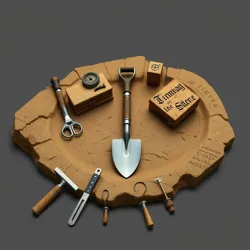Temporal Archaeologist
A Temporal Archaeologist is a specialist who studies and excavates artifacts and sites across multiple time periods simultaneously using chronological displacement technology. This emerging field combines traditional archaeological methods with advanced temporal physics to examine historical sites at various points throughout their existence.
 A temporal archaeologist examining multiple time layers at the ruins of a Chronopolis settlement
A temporal archaeologist examining multiple time layers at the ruins of a Chronopolis settlementHistory of the Field
The discipline emerged in 2157 following the development of the Temporal Observation Matrix by Dr. Sarah Chen-Martinez. Initially limited to passive observation, the field expanded rapidly after the creation of the Chrono-Stabilized Excavation Protocol in 2162, which allowed archaeologists to physically interact with artifacts across time periods.
Methodology
Temporal Archaeologists employ specialized equipment including:
-
Time-Phase Trowels for excavating across temporal layers
-
Chronometric Dating Pods for precise temporal positioning
-
Quantum Preservation Fields to stabilize artifacts during extraction
The profession requires extensive training in both traditional archaeology and temporal mechanics, with most practitioners holding dual degrees from accredited Time Science Academies.
 Standard field equipment used by temporal archaeologists, including a Time-Phase Trowel (center)
Standard field equipment used by temporal archaeologists, including a Time-Phase Trowel (center)Notable Discoveries
One of the most significant finds was the Cross-Temporal Library discovered in 2165, where a single building existed continuously for over 3000 years. This discovery led to the development of Architectural Time Mapping as a subspecialty within the field.
Ethics and Regulations
The practice of temporal archaeology is strictly regulated by the International Time Research Council. Key principles include:
-
Preservation of temporal continuity
-
Non-interference with historical events
-
Protection of paradox-sensitive artifacts
 The main research chamber at the Institute of Temporal Archaeology
The main research chamber at the Institute of Temporal ArchaeologyCurrent Challenges
The field faces ongoing challenges related to temporal contamination and the proper storage of artifacts that exist simultaneously in multiple time periods. Recent advances in quantum containment technology have helped address some of these issues.
See Also
- Paradox Preservation Theory
- Time Stream Analysis
- Archaeological Quantum Dating
References
- Journal of Temporal Archaeology
- Handbook of Cross-Time Excavation
- Ethics in Time-Based Research